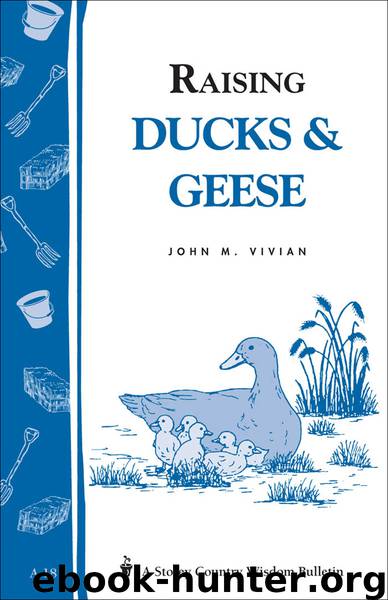Raising Ducks & Geese by John Vivian

Author:John Vivian
Language: eng
Format: epub
Publisher: Storey Publishing, LLC
Published: 1977-03-26T16:00:00+00:00
Culling the Flock
Culling out the poor producers is less of a problem with ducks than with chickens. Occasionally one may develop a heavy, drooping wing, and it just gets slaughtered early. Ducks penned in sanitary quarters or allowed to forage over sufficient land seldom develop problems.
Slaughtering and Dressing Ducks
Commercial duckling producers hang the birds up on assembly lines, remove most feathers with revolving drums covered with rubber fingers, then coat the whole birds with wax that’s removed along with pinfeathers. We don’t get quite so elaborate and have found that doing six birds in two three-bird batches is an easy early evening chore.
First, a big old canner is two-thirds filled with water and brought to a boil on the wood stove. (We always wait until after a bug-killing frost to slaughter livestock, so that the weather’s gotten chilly enough that the stoves have been put to work again.)
Then I catch three ducks by their necks, hang each to a convenient tree limb by both its feet, and cut the throat just behind the bill. Once the birds are bled, they are dunked one at a time in the now not quite boiling water and are swished around hard. The heat cooks the muscles, causing the feather follicles to release the feathers.
The pinions (flight feathers on wings and tail) are the first to come out, and then the rest. If the hot water bath has been long enough, they come off practically in sheets. If you have the time and patience, remove the outer layer of feathers first. Then remove, wash, and save the soft underlayer of down. Use it in pillows or sell it. Well-washed down brings a few dollars a pound, though it takes a lot of ducks to make a pound of down.
To dress a duck you can go through the bother of opening it up and cleaning it whole. We split ours. First, head and neck end are chopped off. The legs are bent so you can see the joint, and the feet are removed. It takes practice, but there are two ligaments alongside the joint that can be cut, and the feet twist right off.
Then the oil gland — the little pointed thing at the base of the tail — is removed. Be sure to get all the yellow, oil-producing tissue.
Next I cut the skin around the vent in a funnel shape, to avoid the gut. With a good pair of poultry shears, I cut up the duck’s back, and it will open up like a book. You’ll recognize the heart, liver, and gizzard. Remove the green bile sack from the liver and the tubes from the heart, and split the gizzard. Discard the contents and the tough muscular liner, which peels off easily once you’ve a good start on it.
Everything else, including tubes and attachments up along the neck, go out. I remove the neck, wing tips, and tail and place them inside the duck, with the giblets, to boil up for gravy. Then, the bird is closed up, using fat flaps to close up the ends.
Download
This site does not store any files on its server. We only index and link to content provided by other sites. Please contact the content providers to delete copyright contents if any and email us, we'll remove relevant links or contents immediately.
Craft Beer for the Homebrewer by Michael Agnew(18122)
Marijuana Grower's Handbook by Ed Rosenthal(3605)
Barkskins by Annie Proulx(3284)
Project Animal Farm: An Accidental Journey into the Secret World of Farming and the Truth About Our Food by Sonia Faruqi(3163)
The Plant Messiah by Carlos Magdalena(2866)
Red Famine: Stalin's War on Ukraine by Anne Applebaum(2856)
0041152001443424520 .pdf by Unknown(2768)
Organic Mushroom Farming and Mycoremediation by Tradd Cotter(2615)
In the Woods by Tana French(2516)
Beer is proof God loves us by Charles W. Bamforth(2356)
7-14 Days by Noah Waters(2342)
Reservoir 13 by Jon McGregor(2226)
Meathooked by Marta Zaraska(2209)
Borders by unknow(2208)
The Art of Making Gelato by Morgan Morano(2202)
Birds, Beasts and Relatives by Gerald Durrell(2164)
Between Two Fires by Christopher Buehlman(2141)
The 7 Habits of Highly Effective People: Powerful Lessons in Personal Change (25th Anniversary Edition) by Covey Stephen R(2118)
The Lean Farm Guide to Growing Vegetables: More In-Depth Lean Techniques for Efficient Organic Production by Ben Hartman(2082)
